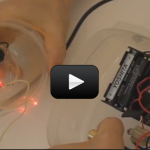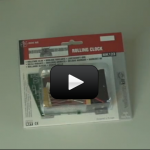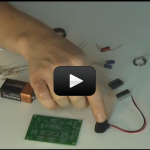This Lesson is for advanced students. In this lesson, you’re going to start building some more complicated circuits. Also, you’ll do it by soldering components to a printed circuit board (PCB). A PCB is basically a pieced of fiberglass with the “wires” stuck to the surface as flat pieces of copper. It makes it way easier to build a circuit that even using breadboards… As long as you have the PCB for it (like if you buy a kit). Making your own PCB’s is an involved process – it’s a lot of work to make one of them, but once you make one, it’s pretty easy to have 10 or 10,000 made. This is why they are used in nearly every electronic device you own these days.
In the videos for these experiments, you’ll learn how to solder. But I just want to mention again how important it is to be super careful with a soldering iron. I mean think about it. It’s a sharp, pointy tool that’s about 700 degrees F (350 C). It can instantly cause severe burns and even catch things on fire.
In the videos for these experiments, you’ll learn how to solder. But I just want to mention again how important it is to be super careful with a soldering iron. I mean think about it. It’s a sharp, pointy tool that’s about 700 degrees F (350 C). It can instantly cause severe burns and even catch things on fire.
Most people who learn about electronics start by studying the theory of how electric current flows through wires and other stuff that conducts electricity, called conductors. Unfortunately this stuff is BORING! I mean, I can’t stand it myself sometimes. So, we’re going to start with what I call “Lego brick” electronics.
You’re going to start by building cool things, then learn what each part of the circuit does, but not go into the minute details. You’ll learn how to build circuits out of electronic “bricks” like you can build something out of Lego bricks. You don’t need to design your own Lego bricks, but just focus on using them. Same thing here – you’ll learn how to put pieces together to build circuits. Our pieces are electronic components. Things like transistors, resistors, integrated circuits (chips), capacitors and lots more.
Although you can't see electricity, you can certainly detect its effects - a buzzer sounding, a light flashing, a motor turning... all of these happen because of electricity. Which is why electricity experiments are among the most frustrating. You can't always tell where the problem is in a circuit that refuses to work right.
We're going to outline the different electronic components (resistors, capacitors, diodes, transistors, etc) so you get a better feel for how to use them in a circuit. While we're not going to spend time on why each of these parts work (which is a topic best reserved for college courses), we are going to tackle how to use them to get your circuit to do what you want. The steps to building several different electronics projects are outlined very carefully so you can really understand this incredible micro-world.
Here are some basic safety rules:
For this lesson, you’ll be assembling kits that you buy. Electronics kits are really popular, and there are probably tens of thousands of different types you can buy. You can get kits for everything from bike light flashers to home stereo systems to computers and robots. If you find you like building kits, it’s a great way to get into electronics.
I’ve selected these particular kits because they’re especially good quality, easy to build and do cool things. It took me quite a while to pick the top kits out there. Many of the kits I went through before settling on the ones in the experiment section were either too difficult to build, had too many components, were made from low quality parts, or were impossible to make work after you built it. Often electronic circuits require troubleshooting and tuning after you put it together (I’ll show you how to do this in the videos), and many of the ones I tested required a seasoned technician to get it to work properly. But don’t panic… I’ve already eliminated the pesky ones and have provided you with the ones you’ll really enjoy building from start to finish.
You’re going to start by building cool things, then learn what each part of the circuit does, but not go into the minute details. You’ll learn how to build circuits out of electronic “bricks” like you can build something out of Lego bricks. You don’t need to design your own Lego bricks, but just focus on using them. Same thing here – you’ll learn how to put pieces together to build circuits. Our pieces are electronic components. Things like transistors, resistors, integrated circuits (chips), capacitors and lots more.
Although you can't see electricity, you can certainly detect its effects - a buzzer sounding, a light flashing, a motor turning... all of these happen because of electricity. Which is why electricity experiments are among the most frustrating. You can't always tell where the problem is in a circuit that refuses to work right.
We're going to outline the different electronic components (resistors, capacitors, diodes, transistors, etc) so you get a better feel for how to use them in a circuit. While we're not going to spend time on why each of these parts work (which is a topic best reserved for college courses), we are going to tackle how to use them to get your circuit to do what you want. The steps to building several different electronics projects are outlined very carefully so you can really understand this incredible micro-world.
Here are some basic safety rules:
- If you’re done using it, unplug it immediately (don’t even leave it for a few minutes).
- If you’re not actively soldering something, put it back in its stand.
- ALWAYS use the stand for it. Never lay in down somewhere else, even for a moment.
For this lesson, you’ll be assembling kits that you buy. Electronics kits are really popular, and there are probably tens of thousands of different types you can buy. You can get kits for everything from bike light flashers to home stereo systems to computers and robots. If you find you like building kits, it’s a great way to get into electronics.
I’ve selected these particular kits because they’re especially good quality, easy to build and do cool things. It took me quite a while to pick the top kits out there. Many of the kits I went through before settling on the ones in the experiment section were either too difficult to build, had too many components, were made from low quality parts, or were impossible to make work after you built it. Often electronic circuits require troubleshooting and tuning after you put it together (I’ll show you how to do this in the videos), and many of the ones I tested required a seasoned technician to get it to work properly. But don’t panic… I’ve already eliminated the pesky ones and have provided you with the ones you’ll really enjoy building from start to finish.






